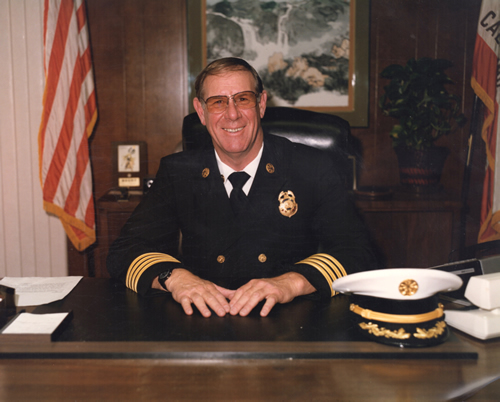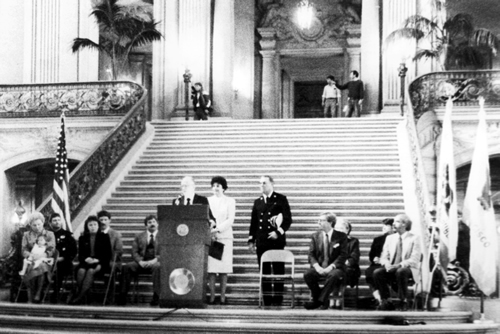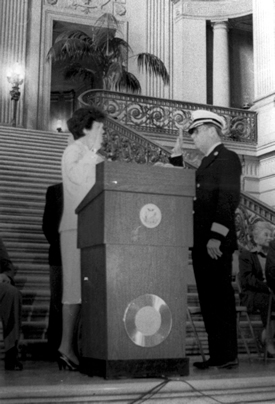|
Chief of Department
1986 - 1988
 |
| |
|
 |
| |
|

Swearing in of newly appointed Chief of Department Edward Phipps by Mayor Dianne Feinstein,
City Hall Rotunda, February 3, 1987. |
- Appointed to the Department: April 23, 1952, age 21, Occupation: Student
- Assigned to Truck Co. No. 13, 1953
- Assigned to Engine Co. No. 41, 1956
- Assigned to Truck Co. No. 1, 1958
- Member, Drill Team, 1952
- Appointed Lieutenant, March 16, 1965
- Assigned to Salvage Co. No. 2, 1965
- Assigned to Rescue Co. No. 1, 1966
- Assigned to Engine Co. No. 17 (Mint Alley)
- Appointed Captain, November, 16,1969
- Assigned to Truck Co. No. 7, 1969
- Assigned to Engine Co. No. 3, 1970
- Appointed Battalion Chief, March 30,1977
- Assigned to Battalion 8 (super swing) 1977
- Assigned to Battalion 2 (swing) 1978
- Assigned to Battalion 1
- Appointed Assistant Chief, May 27,1982
- Assigned to Division of Support Service 1982
- Assigned to Division No. 3, March 24, 1985
- Appointed Deputy Chief of Department, April 1, 1986
- Appointed Chief of Department, December 28, 1986
- Retired, February 1, 1988
- The son of Fred Phipps, SFFD member 1912-1944, retiring as Lieutenant.
-
1944-1950, Presidio of San Francisco Fire Department retiring as Assistant Chief.
- Chief’s Phipps, son, Tim, was a member of the Presidio of San Francisco Fire Department retiring as Fire Chief.
For Chief Edward Phipps, the San Francisco Fire Department was “the family business” his entire life. His father, Fred Phipps, had become a member of the department in 1912, so the fire department and “fire stories” were commonplace around the Phipps evening dinner table. In addition, Chief Phipps’ son Timothy retired as Fire Chief at the Golden Gate National Recreation Area at The Presidio of San Francisco. He also has a son, Kevin, who is a retired Sergeant from the San Francisco Police Department and another son, Michael, who is a teacher and author, teaching history at Skyline College.
Chief Phipps grew up in San Francisco where he attended Sacred Heart Preparatory High School where he was known as an outstanding athlete and good student. After high school, he joined the United States Navy, where he saw action in Korea during the Korean War.
After returning home from the war, he enrolled in college. He joined the Presidio Fire Department, but, when the opportunity came for an appointment to the San Francisco Fire Department, the choice was obvious and the rest is history.
Young Phipps was a “natural” on the fire department—he loved every minute on the job and excelled in the skills and knowledge it took to get promoted.
He was promoted to Lieutenant 12 years after being sworn in to the department—a relatively short time in those days. Then, just five years later, he was again promoted, this time to Captain.
After attaining the rank of captain he was assigned to Engine Co. No. 3, one of the busiest companies in the nation. It was one of Phipps’ favorite assignments because of the diversity of the building stock and population served by the unit. Engine 3 is located at 1067 Post Street in the heart of the Tenderloin District. To the east of the Tenderloin are the high rise buildings of the financial district, to the north the posh homes of Nob Hill, to the west the old Victorian homes of the Western Addition and to the south the wood framed buildings of the inner Mission district. This diverse “first due” area continuously called for different applications of fire ground practices and is one reason that Engine 3 is held in high esteem within the department and considered an ideal preparatory assignment for any future Chief officer.
In 1970 Captain Phipps became one of the founding directors of the California Firemen’s Athletic Association that governs the State’s Firefighter Summer and Winter Olympics. He later served as the association’s president. The Firefighter's Olympics began in 1970 as an opportunity for all California firefighters to get together in a friendly competition that promoted physical fitness in 29 areas of competition and provided an informal forum for exchanging ideas and creating professional ties with firefighters across California.
As a Battalion Chief, Phipps distinguished himself by serving as the San Francisco Fire Department’s Project Officer for the first course deliveries of the new National Fire Academy (NFA) in 1979. While the NFA was preparing to move to a permanent campus in Emmitsburg, MD, the San Francisco Fire Department hosted a two-week series of “cluster” courses (15 course offerings) at the Presidio of San Francisco. Chief Phipps first venture into the national fire service scene was a huge success and clearly demonstrated his leadership and management potential. Chief Phipps attended the prestigious Executive Development III class which was the Charter Class of the new National Fire Academy campus at Emmitsburg, Maryland.
Still enjoying the success of the NFA Cluster Courses, the San Francisco Fire Department was approached in 1983 to assist with a demonstration project for new residential sprinkler technology that was being funded by the United States Fire Administration (USFA) and needed “real world” demonstrations to support the laboratory theory and engineering designs behind the new technology.
A public-private partnership involving the USFA, the International Association of Fire Chiefs, the National Fire Protection Association, the National Fire Sprinkler Association, Underwriter’s Laboratories, Factory Mutual, Marriott Hotel Corporation, the insurance industry and the sprinkler manufacturers was organized to conduct 16 full scale tests in an old Marriott hotel slated for demolition. The goal was to explore the comparative effects of standard sprinklers with new residential sprinkler technology. Chief Phipps was a known and reputable point of contact in those days and he was USFA’s “go to” man. He assisted John “Sonny” Scarff of the Marriott Corporation with all of the logistics needed to insure that safety of the surrounding buildings and the scientific integrity of the test protocols.
The success of Operation San Francisco, as it was called, was pivotal and launched a new era of fire protection and life safety around the world. These tests confirmed earlier test data that suggested survivability in the compartment of origin (room of origin) for an unwanted residential fire. The success of the demonstrations was in large part due to the efforts of Chief Phipps to insure all of the logistics and program arrangements were executed safely and with complete perfection.
As a result of Operation San Francisco, Chief Ed Phipps became a recognized name in national fire service circles. To many in the fire service in 1984, Chief Phipps was the face of the San Francisco Fire Department and was clearly a future leader of the department.
Chief Phipps was known for his strong belief in Physical Fitness for Firefighters. He helped to develop a program at the NFA in 1979 that became part of the curriculum at the NFA. Phipps assisted with the developing of a physical fitness program for the SFFD and as Chief funded workout rooms in almost all of the stations.
Here are the highlights of Chief Phipps’ accomplishments as Chief of Department:
- Persuaded city leaders to adopt a new city fire code that included important updates and brought the city’s fire code into harmony with the State’s Uniform Fire Code. This streamlined code enforcement, encouraged building inside the city limits and reduced costs for building owners and businesses;
- Recognizing that “automation” and “information technology” was not only the wave of the future, but the answer to improving productivity and staffing shortfalls, Chief Phipps became a leading advocate for computers in the fire service, long before other departments and other cities recognized their value. He managed to get a computer on almost every desk and established a new Management Information Systems Bureau in the department to support the new hardware, software and training requirements;
- Chief Phipps’ efforts to leverage technology to improve productivity also put light on the issue of the fire department’s aging Computer Aided Dispatch (CAD) system. Being well known and well liked by business and community leaders, Chief Phipps was able to get pro bono assistance from the IBM Corporation to conduct and in-depth transfer and feasibility study to map the way forward for a replacement CAD system for the fire department. Once that phase was successfully completed, Chief Phipps went to work to obtain the $8 million needed to fund the upgrade. When Mayor Diane Feinstein made that commitment along with Chief Administrative Officer Rudy Nothenberg, the new system was all but a “done deal”. As the saying goes, “close only counts in Horseshoes” and just months later, a new mayor eliminated the money from the fire department budget and the hopes for a new, more accurate and efficient CAD system evaporated in an instant;
- At the outset of his administration, Chief Phipps found the department buried in a tangle of complex lawsuits and court orders involving hiring and promotion of women and several minority groups. Understanding the gravity of the situation and the toll these issues were having on the morale and reputation of the department, Chief Phipps established a collegial and cooperative relationship with the courts to find “the way forward” in the most expeditious manner possible. While some of the outcomes were not satisfactory to every interest or group within the department or the community, settling these matters through the courts enabled the department to begin with a fresh, solid start and to begin addressing known shortfalls in the decisions in a meaningful fashion. Looking back today, leaders from the minority communities have agreed that Chief Phipps’ leadership not only helped solve the issues, but built a new level of trust and understanding between the community and the fire department;
- Once the legal issues were settled, Chief Phipps and the department faced numerous ancillary challenges that laid between the agreements and achieving the promised “end state”. As Chief of Department, Chief Phipps was ultimately responsible to change the culture of the department and frame its attitudes and values for the future. This was a huge undertaking and had to be pursued with all seriousness and determination. More immediate though was needed to quickly modify the department’s training programs to validly address the needs of women and minorities without the appearance of compromising performance. In the end, the department was successful in achieving this delicate balance in their updated training programs. The San Francisco Fire Department spent countless hours studying the Los Angeles Fire Department’s training program that had been deemed by the courts to be reasonable and relevant. The new SFFD training program spoke volumes to both sides of the gender and minority issues—first, because it was considered by most to be one of the more difficult programs and also, because it withstood a court challenge by three recruits who had been terminated for not meeting its standards;
- In an era where high-rise firefighting was relatively new and each incident would highlight major new considerations in the high rise fire challenge; Chief Phipps took a proactive position to prepare for such a fire in San Francisco. His senior leaders gleaned the lessons to be learned from fires in Los Angeles, New York and Chicago high-rise incidents and translated them into new evolutions and drills that would effectively address what had challenged others before. Every week, firefighters from a different area of the city would drill in a high rise and become familiar with its elevator and fire protection systems as well as the latest high rise procedures and evolutions developed by the department;
- Chief Phipps’ proclivity for physical fitness may not have been as widely hailed in the 1980s, as it would be today. Phipps loved to swim and almost daily, swam from the South End Rowing Club by Fisherman’s Wharf out to Alcatraz Island and back, generally missing “his swim” less than 10 days a year. Throughout his career it was always evident with one look that Chief Phipps was remarkably fit. After becoming Chief of Department, Chief Phipps was surprised to learn that injuries and disability retirements were costing the department over $1 million annually. Phipps researched further and learned that many of these lost time and disabling injuries were either avoidable or a result of poor physical conditioning. Without fanfare, Chief Phipps made sure the word went out to step up the health and fitness programs. To remove any threat and promote the cause, he saw that every firehouse in the city was equipped with physical fitness equipment;
- Knowing that his father became a member of the San Francisco Fire Department just six years after the 1906 earthquake and knowing that the city had burned down six times before the earthquake, one would expect that life-long San Francisco resident Edward Phipps would have a great appreciation for disaster planning. That was certainly the case during Chief Phipps’ tenure as Fire Chief. Not only did he drive the revision of the department’s Disaster Plan, he broadened the plan’s scope and made it more comprehensive by involving a host of public and private stakeholders in the process. Military installations (Army, Navy and Coast Guard), large corporations and building owners and managers were brought into the process for the first time and even more importantly, their involvement took root in the process for years to come. The Disaster Plan of the 21st century is better because of the groundwork laid in the process in 1987.
- While the items listed above could be called the “bricks” of what Chief Phipps built during his time as Chief, certainly there was the “mortar” that helped hold it all together. This Chief was highly visible to both the department and the community and during his tenure, he had a number of articles published in the national fire journals and helped develop the emerging programs of the new National Fire Academy and FEMA’s Emergency Management Institute. Chief Phipps believed in “getting tasks accomplished through people” so he was unusually visible in his work with “his committees” in gleaning new ideas from all levels of the department and cultivating the consensus he knew would be necessary for the department to move forward without autocratic rule. What some would call the “little things” like getting a new, state-of-the-art Hazardous Materials Unit put into service or establishing a Crisis Management Team or getting the Civilian Fire Reserve their own quarters were small but constant signals that everyone mattered, everyone was on the same team and everyone could contribute to the betterment of the San Francisco Fire Department.
Back to the Top |





